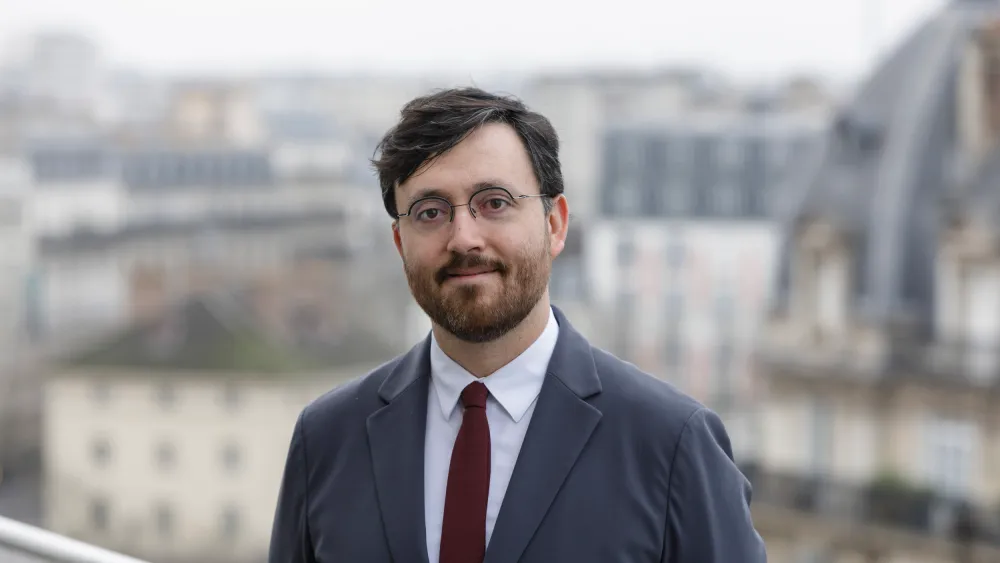Copyright Variety

Possibly the most powerful figure in French cinema, Gaëtan Bruel, who became the youngest president of the National Film Board (CNC) earlier this year at the age of 37, is on a mission to build alliances with American filmmakers, guilds and streamers. Bruel – who lived in New York for several years until 2023 as the former head of French Cultural Services, a division of the French Embassy — is making his first official trip to the U.S. under his new role this week, to take part in The American French Film Festival (TAFF) which kicks off today (Oct. 28). In an interview with Variety on the eve of his departure for L.A. to attend TAFF, Bruel discussed the increasingly large role of France in international cinema, which is reflected in the large number of French co-productions among the official Oscar submissions, including this year’s French Oscar candidate, Jafar Panahi’s Palme d’Or-winning “It Was Just an Accident.” Bruel, who previously worked closely with the CNC to promote French talent in America and helped create Villa Albertine, a U.S. residency program for French creatives, also talked about his mandate to bolster the profile of France as a top filming destination for American filmmakers tackling mid-budgeted, ambitious projects, on the heels of Jim Jarmusch‘s Golden Lion-winning “Mother Father Sister Brother,” among others. He also addressed U.S. President Trump’s threat of imposing tariffs on movies produced outside of France; and the country’s evolving relationship with streamers; as well as the importance of its windowing model to protect theaters and independent film financing at a crucial time when “all premium creative models in the moving-image space are being disrupted by low-cost ones powered by AI, free platforms, and new forms of piracy.” Every year, France is behind so many movies submitted for the international feature film category at the Oscars. How many of them are co-produced by France this year? This year, nearly one-third of the films submitted for the International Feature Film category were co-produced with France, and more than 20% received support from the CNC. Out of 86 submissions, 27 were French co-productions and 19 benefited from CNC funding — Kleber Mendonça Filho’s “The Secret Agent,” Diego Céspedes’s “The Mysterious Gaze of the Flamingo,” Oliver Laxe’s “Sirat,” Laszlo Némès’s “Orphan,” Maryam Touzani’s “Calle Malaga,” Tarik Saleh’s “Eagles of the Republic”, Joachim Trier’s “Sentimental Value,” among many others. France’s Oscar committee chose Jafar Panahi’s Palme d’Or winning film “It Was Just an Accident” which triggered some criticism in some French circles because it’s a Persian-language film shot with Iranian actors. What’s your position on that issue? I saw zero controversy. I just saw attempts at controversy. This is not the first time that France has chosen a film by a foreign director to represent it in this category. “Mustang” in 2016, directed by Turkish director Deniz Gamze-Erguven. The following year, “Elle,” by Paul Verhoeven, who is Dutch. And looking beyond France, there are many precedents: “The Seed of the Sacred Fig” by Mohammad Rasoulof, submitted by Germany last year; “Amour” by Michael Haneke, a French film that represented Austria; or “Perfect Days” by Wim Wenders, which was Japan’s submission. “This Was Just an Accident” fully meets the Academy’s criteria. It is a French co-production that could not have been realized without the decisive contribution of France and its production ecosystem. This film grew out of a long-standing collaboration between French producer Philippe Martin and Jafar Panahi who had previously worked together on a short film. The trust between them is a powerful symbol of the confidence that France places in the world’s greatest filmmakers, especially those who face threats or censorship in their own countries. But before being a film born of extraordinary circumstances, it is, quite simply, an extraordinary film. That is why the independent selecting committee decided that it was the best positioned to win the Oscar after the Palme d’Or, and France is extremely proud to stand behind it. Why is France playing an increasingly active role in international cinema today? In France, we place equal faith in French cinema and in a universal idea of cinema. That is why we choose to support French talent first and foremost, but also a strong ecosystem of production, distribution and international sales that helps sustain cinema around the world. This ranges from Jafar Panahi, who worked with Philippe Martin, to Brad Pitt whose company Plan B — behind “F1” — is now part of Mediawan, the group founded by Pierre-Antoine Capton. At Cannes this year, among the eight films that received awards, one was French and five had been supported by the Aide au Cinéma du Monde. The “ACM” is the largest co-production fund in the world, with a budget of €7 million, and the only one that provides up to €300,000 per project. The ACM supported 17 films in the race for the International Feature Film category this year, including Panahi’s. We’re in a process of increasing the amount of the fund for next year. It’s a critical moment for cinema, and France stands with those who uphold its highest ideals worldwide. At a time when we so often speak of art but think mostly in terms of industry, we owe it to filmmakers like Jafar Panahi to stay true to what cinema truly is. Streaming services tend to view films like audiovisual product and they’re lobbying to launch them on their platform in France as close as possible to their theatrical release. That won’t happen anytime soon I’m guessing? You can’t have your cake and eat it too. You can’t hope for a strong theatrical market if you don’t stand up for it. Let’s not ask the impossible of movie theaters — to be both desirable and distinctive while their efforts are undermined by an all-too-brief window of exclusivity. I’m sometimes told it’s easier to release a film in Germany. But the German market is only half the size of France’s, even though Germany has a larger population. France is the third-largest box office after the United States and China, even though it ranks only seventh in economic power and twenty-third in population. Cinema is part of France’s DNA — and that’s what makes the French market one of the most resilient in the world amid the current decline in theater attendance. In countries where films have been reduced to mere by-products of the wider audiovisual industry, cinema itself faces an existential threat. Korea is a striking example — once seen as a driving force. When the focus shifts solely to the industrial dimension, or when trade agreements undermine cinema — as happened with the 2006 U.S.—Korea accords — cinema risks being swept away entirely. Today, cinema attendance has dropped by 40% worldwide between 2019 and 2024, but in Korea, the decline is even steeper — around 60%. In 2019, the country recorded 220 million admissions; this year, it may fall below 100 million. The situation in film production is even more alarming: output has shrunk fivefold over the same period, as investors have lost confidence in the theatrical market. As a result, in 2024 Korea saw a record 228 re-releases of older films, simply to fill screens — many of which are now being converted into religious halls or even indoor hiking spaces. You’ve mentioned before that streaming platforms can be strategic allies of cinema. How would that work in a regulated market like France? Preserving a balanced window of theatrical exclusivity doesn’t mean that streaming platforms aren’t welcome in this market — quite the opposite. In fact, the rivalry between theaters and platforms, between the big screen and the small screen, belongs to the 2010s and now feels increasingly outdated. We are entering a new paradigm: today, I do think streaming platforms and the film world can work hand-in-hand — as long as they recognize the need to protect theaters. When you look at all the studies about young people’s viewing habits that have come out in the last three years, you notice that the competition is no longer primarily between streaming competing and cinemas, nor is it even between video games and streaming. There is a shift in audiences towards social media and free platforms, and it affects everyone, and especially streaming streamers. Do you view microdrama as a worrying trend that could hurt moviegoing? I’ve just returned from a trip to Korea, where a full season of 60 two-minute episodes costs around $200,000 to produce. That’s the going rate for a microdrama today. In France, this format has exploded across social media over the summer: each episode is like a two-minute ad — you click, you watch, and you’re sent to a dedicated platform. In China, the microdrama market actually surpassed theatrical box office last year — despite the country having 94,000 cinema screens. This may sound like good news for some, who see clear financial opportunities in it, but for the industry as a whole — and for audiences — the rise of microdrama, which epitomizes a low-cost content model, is not encouraging news. Our societies are increasingly endangered by our relationship with screens. We’ve never spent so much time in front of them — and yet, paradoxically, never spent so little time truly watching what they show. Why do you think most streaming services are perceiving theaters differently today? Theatrical releases create value — community, cultural conversation, media resonance, and revenue — in ways that streaming platforms alone have never managed to generate. But there’s more. Streamers and theaters now face a common threat. According to Deloitte’s latest “Tech Trends” report, 57% of young people prefer watching video content on free or social platforms over every other form of audiovisual experience — cinema, streaming, and gaming combined. Even video games are under pressure: we are seeing a generation of gamers smaller than the one before, as audiences increasingly choose to watch a handful of players on YouTube or Twitch rather than play themselves. The reality is that all premium creative models in the moving-image space are being disrupted by low-cost ones, powered by AI, free platforms, and new forms of piracy. Even YouTube, which appears triumphant today, cannot be entirely confident about its future as we witness the rise of AI. In this landscape, facing a shared threat, streamers and theaters have more in common than they think, starting with their most precious asset: regular audiences. Studies show that the more streaming subscriptions people have, the more often they go to the cinema, and vice versa. That’s precisely what both streamers and theaters need most: audiences who choose to watch films and series over other forms of video content. There’s actually been alliances formed in France between streaming services and TV groups. Yes, absolutely. The recent distribution deals between TF1 and Netflix, and between France Télévisions and Amazon Prime Video, are good news for both cinema and series. When the value of linear broadcasting declines sharply, it becomes essential to forge alliances with native digital players — but these platforms, in turn, have much to learn from the advertising expertise of strong private broadcasters, and from the audience engagement cultivated by major public ones. It shows once again that different models are not necessarily in opposition — and that those who thrive on framing divisions may, in the end, find themselves standing alone. I’m not making a political point here. But Netflix and Amazon Prime Video have also lodged an appeal to the France’s Council of State over windowing rules which force them to wait 15 to 17 months to access films after their theatrical release. What’s the latest with that? Their complaint doesn’t target the rules themselves, but rather a specific extension that has not yet met their request to move up in the release window — it’s quite different. They are not questioning the system as a whole — at least not in France, where their legal approach remains less aggressive than in other parts of Europe. From my understanding, their aim is to advance the discussion about their own positioning within the French release window system. What they dispute is the temporary outcome of a specific negotiation with industry organizations, which have not yet responded to their proposal — a negotiation that is entirely theirs to pursue. I would note that Disney+ has successfully completed such a negotiation, with its window shortened from 17 months to 9 months in exchange for additional investment in French cinema. That alone shows that the discussion remains open. Don’t you think that the French windowing system is increasingly obsolete? On the contrary, I believe it is more relevant than ever. Our windowing system — which Tom Rothman, Chairman and CEO of Sony Pictures, recently praised — serves two essential purposes. The first, as I’ve already mentioned, is to protect theaters during the crucial first weeks of release. In France, films benefit from a four-month exclusive theatrical window. As a direct result, France has the densest network of theaters in the world: 90% of the population lives less than thirty minutes from a theater, and for the remaining 10%, they are itinerant circuits ensuring that no region becomes a “cinema desert”. This is a major reason why cinema remains such a deeply rooted part of everyday life in France. Every village wants to have its school, its bakery — and its cinema! The second purpose is to secure film financing through a clearly defined sequence of exclusive windows. Since filmmaking is both costly and complex, the French model structures a film’s life cycle to reflect levels of investment — allowing those who contribute the most to appear earliest in the chronology, and those who follow to participate proportionally. The French box office has suffered in 2025. It’s been down compared with last year. What happened in your opinion? We’ve just come off a strong year in 2024, with 182 million admissions — a drop of only 15% compared to 2019, while global theatrical attendance declined by 40% over the same period. We had an excellent slate of films, including French productions, which captured a 44% market share — twice Italy’s 22%, and six times the UK’s 7%. This shows that our model continues to produce films that truly resonate with audiences. The same is true for television: last year, 100% of the highest-rated prime-time dramas were French. That said, the beginning of this year has been more challenging, as we’ve had a double effect from lower output of American and French films. So our message to Hollywood is simple: send us more films — great films, and a greater variety of them! And the same goes for French producers. France isn’t just a country accustomed to cinema — it’s a country passionate about it. It’s in the DNA of the French to go to the movies whenever there are films they want to see. We just need those films to exist. Having said that, I’m working on a plan to bring admissions back up to 200 million — close to our pre-pandemic level. How do you plan to achieve that goal of getting moviegoing back to 200 million admissions in the next couple years? First, we must continue to offer a genuine diversity of films, from France and beyond, for every audience and every taste. In this respect, France is one of the few countries capable of producing such a wide range of cinema: dramas, comedies, historical epics, action and adventure films, romantic comedies, thrillers, and genre films… Second, we must keep protecting and supporting our movie theaters. We feel very strongly that cinemas are local cultural landmarks, deeply rooted in the daily life of our communities. Third, we need to be far more proactive in what we call in France éducation aux images — film literacy, or education to screens through cinema. For forty years, a national program has enabled 80,000 teachers to take 2 million students — from kindergarten through high school — to the cinema three times a year. Every study confirms its extraordinary impact. When you give a six-year-old the experience of the big screen, you can spark an emotion that lasts a lifetime. Exhibitors love it, too, because it benefits them in both the short and long term. These screenings take place when theaters are least busy, with reduced tickets funded by the state and local authorities — and in the long run, those children become their audiences of tomorrow. Today, only 15% of our young people experience this program each year. Our goal is to raise that to 30% in the next few years — and ultimately, to reach every child in France. You’re about to travel to the U.S. on your first official visit there since you took the helm of the CNC. Why was it important for the CNC to become a partner of TAFF? I’m very happy to be back in the United States for the first time since becoming President of the CNC. I spent four years in New York in my previous role and often traveled to Los Angeles, where I had a team and established a branch of Villa Albertine — France’s network of creative residencies I created across the United States. I’ve come to Los Angeles first and foremost for the TAFFF, which has been running since 1997. Its name has evolved over time, but its core mission remains the same: to promote French cinema in the United States. In Europe, American films account for 60% of the box office, while European films represent barely 1% of the U.S. box office — and, of course, France’s share is even smaller. By joining forces with the DGA, the MPA, the WGA, and the SACEM — the French society of authors, composers and music publishers — which are behind the TAFF, the CNC, together with Unifrance, aims to strengthen connections between our industries and foster in-depth dialogue on the major challenges we face today. I personally believe that our ties are stronger than political stances or legal disputes. When France and the United States talk about cinema, it’s not just two countries discussing business or creative interests — it’s the two nations that invented cinema and shared it with the world, coming together to help shape its future. Besides showcasing French movies and series, I know you’re also looking to promote French locations and facilities to American producers at TAFF. In just a few years, there was a lot of change in France. The France of today is no longer the one you once knew — the country you went to for a holiday after a film shoot, rather than a place to actually make one. Our strengths now go far beyond our tax incentive — though it remains one of the most attractive in the world, offering up to a 40% credit with no annual cap. Five years ago, President Macron launched an ambitious plan, “France 2030,” to double our training and production capacity. That plan is now nearing completion, and the transformation it has brought is already remarkable. As part of this year’s TAFF, we’ll highlight two case studies that embody this renewal: “Head of State,” one of Amazon Prime’s biggest global hits, which was largely filmed in France, and “Father Mother Sister Brother,” winner of the Golden Lion. Jim Jarmusch will also join us to share his experience shooting in France. You’ll also talk about how France can bring financial support to independent American cinema besides hosting shoots, right? In recent years, the sustainability of mid-budget dramas has become an existential issue in the United States. Finding a viable economic model for these films — which are neither the blockbusters sought after by platforms nor small independent productions, but ambitious works that aim to reach a wide audience — has become increasingly complex. France firmly believes in these films. They are precisely the kind of projects we’ve been welcoming recently — and we hope to see more in the years ahead. I’m thinking of “The Substance,” made for €22 million, and “Emilia Perez,” for €26 million — figures my American friends never believe when I mention them, assuming the budgets were at least twice as high. To put it another way, our goal is not to attract the next Marvel productions, but to be the preferred partner of American independent cinema. Jim Jarmusch — whose latest film was partly shot in Paris — embodies this vision perfectly, and I’m delighted that he’s expressed his desire to work even more closely with France in the future. President Trump has recently threatened to put in place tariffs on films produced overseas. What do you think of that threat and do you anticipate that it will refrain some producers from coming to France? It seems to me that the logic behind this statement applies more to the car industry than to the film industry — but since it’s the second time we’ve heard it, no one is taking it lightly. It comes with real risks: American professionals could find themselves caught between an impossible financial equation and potential retaliatory measures. I completely understand Michael Mann’s position when he says, “I want to shoot in Los Angeles — you have to help me make that possible.” This isn’t about taxing films; it’s about improving tax incentives, and ideally creating one at the federal level. From France’s perspective, again, we’re not trying to attract the next “Avengers” or “Spider-Man.” Rather, we just believe there are specific projects for which shooting in France makes perfect sense — and we’re working hard to make that both technically and financially appealing. It’s also worth noting that 80% of our film production remains national. And it’s precisely by strengthening the international reach of our domestic production that we’ve raised our crews to world-class standards — without relying solely on projects from abroad. In other words, the unique vitality of our homegrown production ensures a healthy, resilient, and dynamic environment for international shoots, with consistently high activity levels regardless of market fluctuations. And we have some of the very best line producers in the world. You should try them! Tilly Norwood crystallized a lot of fears around AI in the U.S. earlier this month. But it seems that there isn’t that much concern over AI in France. Why is that do you think? The reason is simple. When you’re a market like France — not the United States — being competitive has always been an obsession. It goes back to the “Nouvelle Vague,” when filmmakers learned to create masterpieces on a shoestring budget. That’s why, in France, we didn’t wait for AI to learn how to do more with less — it’s been our hallmark since the 1950s. So when people in the U.S. were talking excitedly about OpenAI, saying, “It’s a revolution — we can now make an animated film for only $30 million,” it made us smile. We made “Flow,” with Latvian partners, for under $4 million — and it won an Oscar. There’s no AI in “Flow,” yet it made animation history. The second reason is that we’re not AI-averse — quite the opposite. The question isn’t whether we’re for or against it; it’s already here. What matters is embracing it fully, but with transparency and responsibility — so that we don’t lose ourselves in the process. Otherwise, the risk we face is nothing less than the collapse of our creative model. Can you elaborate on the model collapse and the reason why you view it as the biggest danger with AI?



